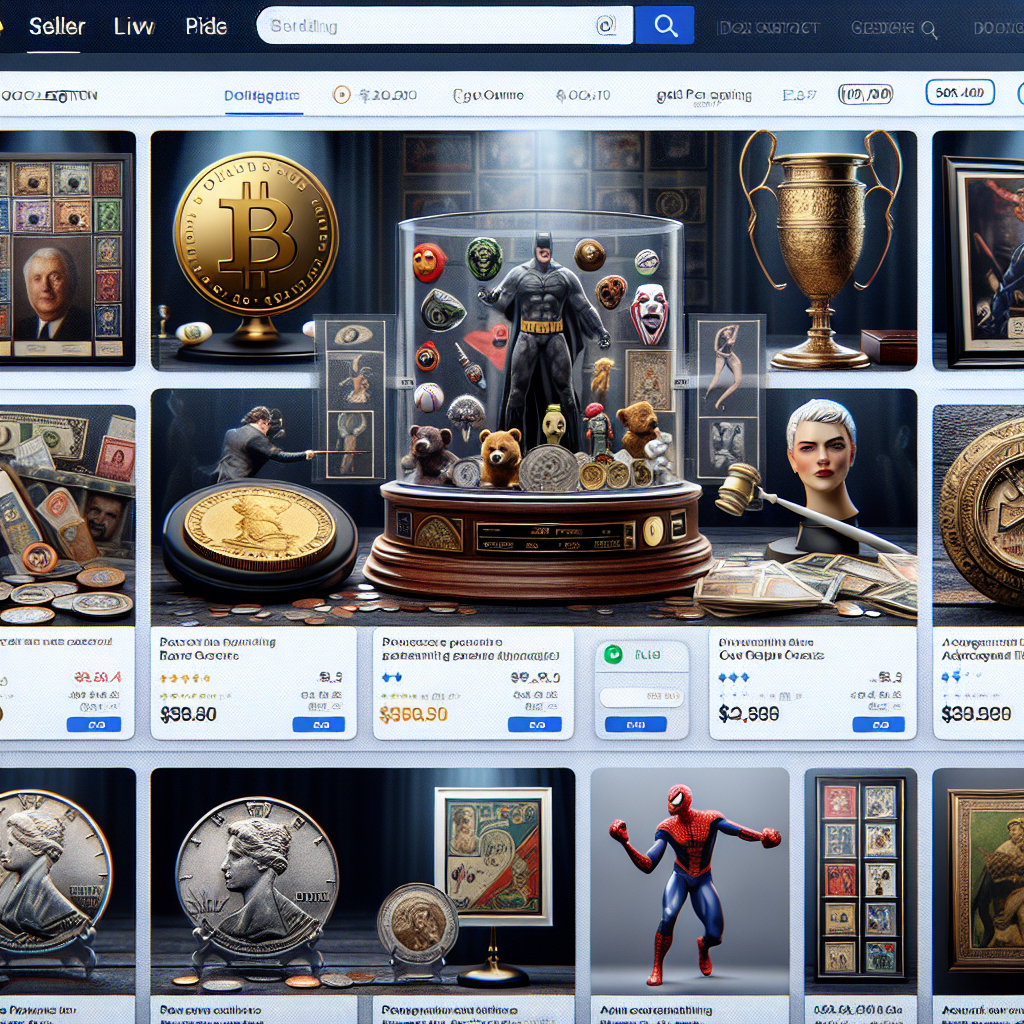
Sell High-Demand Collectibles on eBay for Premium Prices
- Understanding eBay’s Market for Collectibles
- Identifying High-Demand Collectible Categories
- Optimizing Your eBay Listings
- Building a Reputation as a Seller
Understanding eBay’s Market for Collectibles
eBay’s Buyer Demographics
Selling collectibles on eBay is really about understanding who your buyers are. From vintage toys to rare coins, there’s a buyer for almost anything. Recognizing that the demographic is often niche—people who are super passionate or just looking for that one special item—can help you tailor your approach. I’ve found that taking the time to research your audience can give you a leg up on your competition.
The platform attracts collectors from all over the world, so you can connect with people who are eager to open their wallets for the right item. It’s worth exploring forums and discussion boards to get a sense of what these collectors are looking for. The more you know, the better you can serve them.
Finally, don’t underestimate the power of community. Engaging with other sellers and buyers can provide invaluable insights. You can learn about upcoming trends or even sell directly to those who have a dedicated following.
Trends in Collectibles
Trends can change faster than you think in the collectibles market, and what’s hot today could be old news tomorrow. I keep my finger on the pulse by following popular blogs, YouTube channels, and social media accounts dedicated to collectibles. Seeing what influencers are raving about can give you predictive insight into what might sell well down the line.
Prized items can vary depending on seasonality—think holiday-themed collectibles during winter months—and of course the effects of pop culture. When “The Mandalorian” hit the screens, Star Wars collectibles saw a surge in interest, and savvy sellers capitalized on it. Keep an eye out for what’s generating buzz and be ready to pivot your inventory accordingly.
Lastly, make sure you’re aware of any constraints that could impact trends. Market saturation can dilute demand for certain items, so staying updated on what’s being offered is crucial to standing out in the crowd.
Price Fluctuations
Understanding market dynamics also involves grasping price fluctuations. Prices for collectibles can rise and plummet based on several factors. Things like condition, rarity, and even recent sales data can shift how much something is worth.
I’ve employed strategies such as tracking past sales to help establish a price. Analyzing similar items sold gives you a solid foundation to start pricing yours competitively. Don’t be afraid to adjust your asking price based on current demand—sometimes, a small tweak can mean the difference between sale or no sale.
Finally, consider using eBay’s auction format for items that are especially rare or desirable. It taps into buyer psychology—the thrill of bidding can sometimes push prices even higher than you anticipated.
Identifying High-Demand Collectible Categories
Popular Categories
Diving into categories of collectibles is like treasure hunting! Some of the more popular areas include sports memorabilia, vintage toys, comic books, and antiques. I’ve found that focusing on specific categories that resonate with your passion can lead to a more fulfilling selling experience.
There’s a certain charm in sharing your love for collectible cars or comic books with others who appreciate them just as much. You’re not just selling; you’re sharing a bit of your world, which brings in genuine interest. If you choose a niche you’re passionate about, research every aspect of it—you’ll become the go-to person for that specific category.
Additionally, try attending local collector fairs or even online expos to see what’s currently in demand. Networking with fellow collectors can give you insider tips that can steer your collection in the right direction.
Niche vs. General Collectibles
When it comes to selling on eBay, you’ve got two main paths: niche collectibles or General collectibles. While general categories might seem easier—with broader audiences—niche collectibles can command higher prices if you nail it right.
I’ve dabbled in both. With niche items, sell them to a dedicated group who are often willing to pay a premium for just the right piece. On the other hand, in a more generalized category, you might sell more frequently but at lower margins. Your choice boils down to how much time and energy you want to invest in researching and marketing your products.
It might also be worth starting in a niche that you truly enjoy—this authenticity is key, and the excitement you have for the items can often translate into better sales.
Assessing Demand
So, how do you assess demand for a particular collectible? I swear by using eBay’s own tools to see what’s selling and for how much. Look at completed listings to gauge how items are moving in real-time. If you find consistent sales with competitive prices in a category, you’re likely onto something great.
Additionally, I recommend checking out other marketplaces outside eBay as well—sites like Etsy, Facebook Marketplace, or even Craigslist. This can help paint an overall picture of demand and give you context to what you’re seeing on eBay.
Keeping an eye on social media, especially Facebook groups or Reddit communities focused on specific niches, provides real-time feedback on what collectors are currently enthusiastic about.
Optimizing Your eBay Listings
Title and Description Crafting
Crafting your title and description isn’t just about slapping some keywords together. I take a good chunk of time to creatively and accurately describe my items. Titles should be eye-catching yet informative—include the brand, model, and any relevant details.
When describing the item in detail, I suggest you highlight its unique features. Buyers want to know: what’s special about your item compared to the rest? I make sure my descriptions are accessible—if I’m selling a collectible comic book, I might include its publication history or describe the condition in detail.
Visuals also matter! So I take the effort to take high-quality photographs that showcase the item from various angles, allowing potential buyers to really feel what they’re getting.
Keywords and SEO
Utilizing relevant keywords can significantly boost your visibility. I usually write down a list of phrases related to my product’s niche and try to use them naturally in my title and descriptions.
Additionally, consider combining your keywords in variations. Buyers may search in different ways, so “rare 1960s action figure” and “1960s action figures in excellent condition” might both draw in the same buyer.
Don’t forget about categorization—using eBay’s suggested categories helps too, as it aids in getting your item in front of the right audience.
Timing Your Listings
I can’t stress enough how timing can impact your sales. Listing your items during peak shopping times, such as the lead-up to holidays or weekends, can enhance your visibility. I’ve learned through trial and error that timing plays a serious role in achieving higher bids.
Moreover, if you’re using auction-style listings, consider starting them at a time when more users are online—like evenings or weekends. This increases the chances of more people seeing your item, which translates into a potential bidding war.
Finally, I use eBay’s scheduling feature, so I can plan my listings in advance and ensure they go live at peak times without me being glued to my phone.
Building a Reputation as a Seller
Providing Excellent Customer Service
Establishing a positive reputation is paramount! I’ve found that providing top-notch customer service can lead to repeat buyers. Answer questions promptly and consider all your interactions as part of your brand messaging—be friendly, approachable, and helpful.
When an issue arises, swift resolution not only keeps you in the good graces of the buyer but often leads to glowing feedback. Sometimes, just being human and understanding goes a long way in building that trust, which is what separates a good seller from a great one.
Being detail-oriented also plays its role. Ensuring that items are packaged nicely and shipped quickly reflects your dedication to service and care.
Encouraging Feedback and Reviews
Feedback is your best friend; it boosts your credibility! I actively encourage buyers to leave feedback after their purchase. After all, who doesn’t love a pat on the back now and then?
A little follow-up message thanking them for their purchase and kindly asking them to share their experience boosts your chances of receiving positive reviews. I usually include a small thank-you note in the package—it’s a personal touch that buyers appreciate.
Keep in mind that if a buyer does leave negative feedback, addressing the issue with grace and professionalism is key. Apologizing and trying to make things right goes a long way toward turning a negative into a positive experience.
Engaging in the Community
Building relationships with fellow sellers and collectors can elevate your eBay experience. Whether you’re engaging through forums, local meetups, or social media groups—sharing tips, tricks, or just your thoughts can open new avenues for achievement.
These connections might lead to collaborative sales or exchanges, gaining you exposure to a larger audience as you promote each other’s collections. In my experience, collaboration often results in collective growth.
Sharing knowledge, resources, and even inventory can be beneficial for everyone involved. Support one another, and you all can thrive in a space that fosters mutual respect and enthusiasm for collecting.
FAQs
What types of collectibles tend to sell best on eBay?
Some of the best-selling collectibles include vintage toys, coins, sports memorabilia, and trading card games. It’s about finding what you’re passionate about and researching current trends.
How do I determine the right price for my collectibles?
Pricing can be determined by researching completed listings on eBay for similar items. It’s also helpful to check other platforms or marketplace statistics. Be prepared to adjust based on demand and condition!
What can I do if my listing isn’t getting any views?
Check your title and descriptions to see if they are optimized with relevant keywords. Also, consider your visuals—great photos can make a huge difference! Timing your listings and promoting them through social media can also increase visibility.
How important is seller feedback on eBay?
Seller feedback is critical—it builds your credibility and trustworthiness as a seller. Aim for positive interactions and encourage buyers to leave reviews; it greatly influences potential buyers’ decisions.
Get it now, your new content producer, that makes your journey so much easier.
This is a wonderfull resource it makes all the difference to your product creation and sales, even giving you a market place to list and sell your product.

